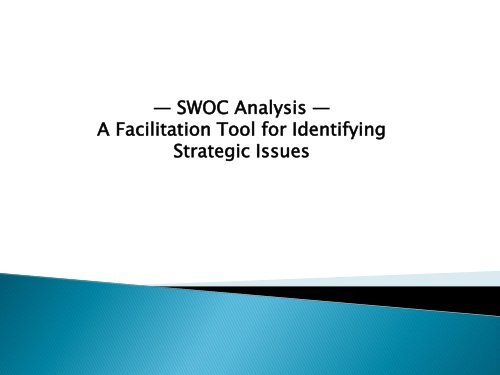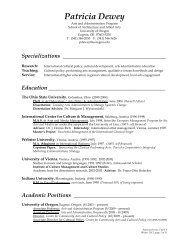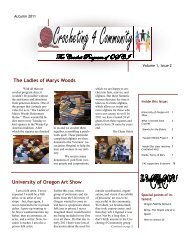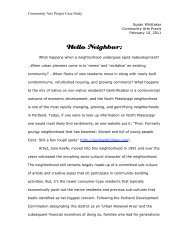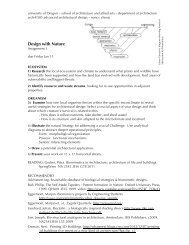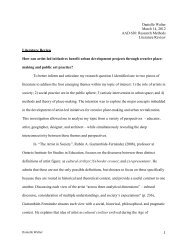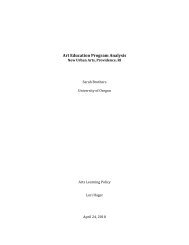SWOC PPT
SWOC PPT
SWOC PPT
Create successful ePaper yourself
Turn your PDF publications into a flip-book with our unique Google optimized e-Paper software.
— <strong>SWOC</strong> Analysis —<br />
A Facilitation Tool for Identifying<br />
Strategic Issues
<strong>SWOC</strong> Analysis is a process of analyzing<br />
strengths, weaknesses, opportunities and<br />
challenges of an organization.<br />
The SWOT Analysis was developed as a<br />
component of the Harvard Policy Model for<br />
strategic planning in businesses. It has been<br />
included in the business policy course taught at<br />
the Harvard Business School since the 1920s.
<strong>SWOC</strong> Analysis has since been expanded to address<br />
a wide variety of purposes including assessment<br />
and development of both for-profit and non-profit<br />
organizations, public agencies, and communities.<br />
<strong>SWOC</strong> Analysis for organizations can:<br />
Help a new group to focus on developing their<br />
mission and first important strategies,<br />
Enable a group that has not been functioning as<br />
effectively as they could be to refocus their efforts<br />
and get on track,<br />
Assist long-term organizations to periodically<br />
renew their priorities in a systematic fashion.
Desired Outcomes<br />
A <strong>SWOC</strong> produces documented lists of external<br />
(future-oriented organizational opportunities<br />
and challenges) and internal (present<br />
organizational strengths and weaknesses)<br />
factors.<br />
Another important outcome of <strong>SWOC</strong> may be<br />
the formulation of specific actions to deal with<br />
challenges and weaknesses, build on strengths,<br />
and take advantage of opportunities.
Benefits<br />
An effective external and internal environmental<br />
assessment should provide several benefits to<br />
the organization.<br />
Among the most important is that it will produce<br />
information that is vital to the organization’s<br />
survival and prosperity.<br />
It is difficult to imagine that an organization can<br />
be truly effective over the long haul unless it has<br />
an intimate knowledge of its strengths and<br />
weaknesses in relation to the opportunities and<br />
challenges it faces.
Every organization must manage the tension<br />
between its capacities and intentions in relation<br />
to the opportunities and challenges it faces.<br />
A <strong>SWOC</strong> analysis clarifies the nature of these<br />
tensions by juxtaposing two fundamental<br />
dimensions of existence:<br />
Good (strengths and opportunities)<br />
Negative (weaknesses and challenges)<br />
as well as<br />
Present (strengths and weaknesses)<br />
Future (opportunities and challenges).
<strong>SWOC</strong> Group Process<br />
The following process description is one example<br />
of how to conduct a <strong>SWOC</strong> Analysis with a group.<br />
Please note that there are many ways to accomplish<br />
the same process. The technique is relatively<br />
simple, easy to use, speedy, and productive.<br />
The technique is particularly useful as a component<br />
of a comprehensive strategic planning effort, as an<br />
environmental scan or strategy development step.
In a SWOT analysis the technique focuses on these<br />
four questions:<br />
1. What are our major internal or present<br />
strengths?<br />
Internal strengths are resources or capabilities that<br />
help an organization accomplish its mandates or<br />
mission.<br />
Examples: professional staff, adequate resources,<br />
leadership, values, physical facilities, talents, linkages or<br />
networks, history, reputation and many others.
2. What are our major internal or present<br />
weaknesses?<br />
Internal weaknesses are deficiencies in resources<br />
and capabilities that hinder an organization’s<br />
ability to accomplish its mandate or mission.<br />
Examples: lack of effective communications,<br />
absence of clear vision or mission, flawed organizational<br />
structure, noncompetitive pay structure, performance<br />
issues, board turnover, or lack of financial resources.
3. What major external or future opportunities do<br />
we have?<br />
External opportunities are outside factors or<br />
situations that can affect your organization in a<br />
favorable way.<br />
Examples: new funding from a federal program, political<br />
support for a potential project, a chance to modify an<br />
outdated mandate, the global economy, changing<br />
customer demographics and preferences, technological<br />
changes, timing and other trends.
4. What major external or future challenges do<br />
we face?<br />
External challenges are outside factors or<br />
situations that can affect your organization in a<br />
negative way.<br />
Examples: loss of state funding, increasing demand<br />
for a specific service, management conflicts, the<br />
global economy, competition, customer preferences,<br />
technological changes, political or social trends.
After the SWAC, take your findings and ask:<br />
What can we do to help build upon or enhance ________<br />
strength?<br />
What can we do to improve or overcome __________<br />
weakness?<br />
What can we do to take advantage of __________<br />
opportunity?<br />
What can we do to minimize or eliminate __________<br />
challenge?
The strategies identified can again be prioritized or<br />
further assessed through more detailed action planning.


